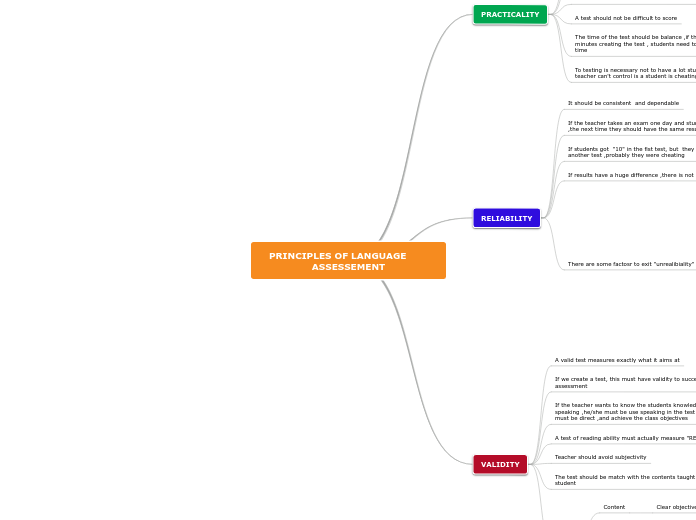PRINCIPLES OF LANGUAGE ASSESSEMENT
VALIDITY
TYPES
Construct
Face
The degree to which a test looks righ
Criterion
Specified classroom objectives are measured
Content
Clear objectives are presented in the test
The test should be match with the contents taught to the student
Teacher should avoid subjectivity
A test of reading ability must actually measure "READING"
If the teacher wants to know the students knowledge about speaking ,he/she must be use speaking in the test ,he/she must be direct ,and achieve the class objectives
If we create a test, this must have validity to succed in the assessment
A valid test measures exactly what it aims at
RELIABILITY
There are some factosr to exit "unrealibiality"
Do the test objective with clear instructions
TEST ADMINISTRATION
Avoid noise when students are having a test , for example in a listening text
If the teacher is tired he/she may score wrong
Rater
STUDENTS-RELATED ISSUES
"Bad day"
Fatigue
Temporary Illness
If results have a huge difference ,there is not realibility
If students got "10" in the fist test, but they got a "5" in the another test ,probably they were cheating
If the teacher takes an exam one day and students got "10" ,the next time they should have the same results
It should be consistent and dependable
PRACTICALITY
To testing is necessary not to have a lot students , because teacher can't control is a student is cheating or not.
The time of the test should be balance ,if the teacher took 10 minutes creating the test , students need to take the similar time
A test should not be difficult to score
A test is practical when it is not to long for students or teachers
Test doen't need to be expensive
To create and effective test we need to be practical

